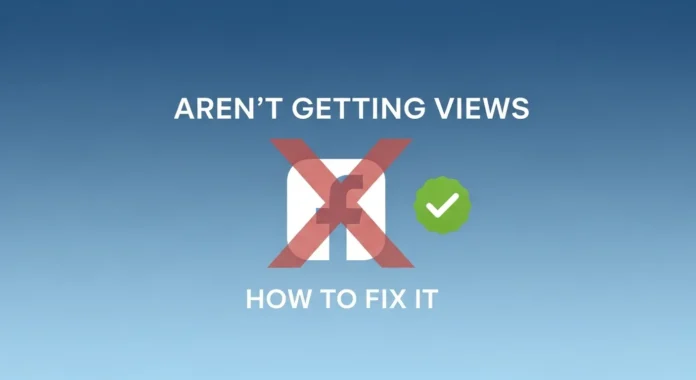You’ve spent hours crafting the perfect Facebook video. The lighting is spot-on, your message is clear, and you’re genuinely excited to share it with the world. You hit publish, wait a few hours, and then… crickets. Maybe twenty views if you’re lucky, and half of those are probably your mom.
Sound familiar? You’re not alone. Thousands of content creators and business owners face this frustrating reality every single day. The truth is, getting Facebook video views in 2025 isn’t as simple as uploading great content anymore. The platform has changed, the algorithm has evolved, and what worked two years ago might be actively hurting your reach today.
But here’s the good news: once you understand why your videos aren’t getting views, fixing the problem becomes surprisingly straightforward. Let’s dig into the real reasons your content is being buried and explore practical solutions that actually work.
The Facebook Video Algorithm Has Changed Dramatically

First things first, we need to talk about the elephant in the room: Facebook’s algorithm doesn’t work the way it used to. Gone are the days when chronological feeds and organic reach ruled the platform. Today, Facebook uses sophisticated machine learning to predict what content each user wants to see, and video content faces particularly tough competition.
The algorithm now prioritizes three main factors: engagement velocity, watch time, and audience retention. Engagement velocity refers to how quickly your video gets likes, comments, and shares right after posting. If your video sits idle for the first thirty minutes, Facebook interprets that as a signal that your content isn’t interesting, and it gets buried before most of your followers even see it.
This creates what marketers call the “cold start problem.” Your video needs immediate engagement to gain momentum, but it can’t get engagement if nobody sees it. It’s a frustrating catch-22 that leaves many creators feeling stuck.
Your Video Isn’t Optimized for the First Three Seconds
Here’s a harsh truth: most people scroll past your video in less than three seconds. That’s how long you have to capture attention, stop the scroll, and convince someone your content is worth watching.
Look at your recent videos honestly. Do they start with a compelling hook, or do they begin with a lengthy introduction? Does the first frame visually grab attention, or is it forgettable? Facebook’s autoplay feature means your video is competing with dozens of other pieces of content in someone’s feed, all playing simultaneously without sound.
The solution? Front-load your most compelling content. Start with the payoff, the surprising fact, the dramatic moment, or the biggest benefit your viewer will get. You can always provide context later, once you’ve earned their attention. Think of it like writing a news article: put the most important information first, then fill in the details.
You’re Posting at the Wrong Time
Timing matters more than most people realize. Posting your video when your audience is asleep, at work, or simply not scrolling Facebook means you’re wasting that crucial first hour when the algorithm is evaluating your content’s performance.
Every audience has different peak activity times, depending on demographics, time zones, and lifestyle patterns. A local bakery’s audience might be most active at 7 AM when people are planning breakfast, while a B2B software company might see better engagement at 2 PM on weekdays.
Check your Facebook Insights to identify when your specific audience is online and active. Then schedule your posts to go live during those windows. This simple adjustment can dramatically improve your initial engagement velocity, which signals to the algorithm that your content deserves broader distribution.
Your Content Isn’t Actually Engaging
This one stings, but it needs to be said: sometimes the problem isn’t the algorithm or your posting strategy. Sometimes the content just isn’t compelling enough to make people stop, watch, and engage.
Ask yourself honestly: Would you watch this entire video if you stumbled across it in your feed? Does it provide genuine value, entertainment, or emotional resonance? Or are you creating content that feels more like an obligation than something you’re genuinely excited to share?
Engaging Facebook videos typically fall into a few categories: they teach something useful, they entertain genuinely, they evoke emotion, or they tell a compelling story. The best videos often combine multiple elements. A tutorial that’s also entertaining will outperform a dry, lecture-style video every time.
You’re Missing Captions and Text Overlays
Since most Facebook videos autoplay without sound, captions aren’t optional anymore, they’re essential. Studies show that captioned videos receive significantly higher engagement rates because people can understand your content even when they can’t turn on audio.
Beyond basic captions, strategic text overlays can emphasize key points, create visual interest, and help retain viewer attention. Think of text as a guide that helps people follow along, even if they’re watching in a noisy environment or trying to be discreet at work.
Facebook’s automatic caption feature is convenient, but it’s not always accurate. Take the extra time to review and correct captions manually. The improved accessibility and professionalism make a noticeable difference in how people perceive your content.
The Cold Start Problem Is Killing Your Momentum
Remember that engagement velocity we discussed earlier? This is where the rubber meets the road. If your video doesn’t gain immediate traction, the algorithm assumes it’s not interesting and stops showing it to people. This creates a vicious cycle where low visibility leads to low engagement, which leads to even lower visibility.
Many successful content creators and brands have found that strategic approaches to building initial momentum can break this cycle. Some collaborate with other creators for cross-promotion. Others engage their most loyal community members to interact with new content quickly. Some businesses even explore services that provide an initial boost of engagement to help their content overcome the cold start problem and reach its organic potential.
Platforms like GTR Socials have built their reputation on helping creators solve this exact challenge. By providing authentic engagement from real users, these services can help quality content gain the initial momentum needed to trigger organic growth. It’s similar to how restaurants place a few people in line outside to signal popularity, that initial social proof often attracts genuinely interested customers.
Your Video Format Doesn’t Match Platform Preferences
Facebook heavily promotes certain video formats over others, and these preferences shift based on their business priorities. Right now, short-form vertical videos, Facebook Reels, and live broadcasts receive preferential treatment in the algorithm because they compete directly with TikTok and Instagram.
If you’re still uploading traditional horizontal videos that are five minutes long, you’re working against platform incentives. Consider reformatting your content to match what Facebook wants to promote. This doesn’t mean abandoning your style, it means adapting your delivery to platform realities.
Vertical videos feel more native to mobile viewing, which is how most people consume Facebook content. Short-form content typically performs better because it matches decreasing attention spans. And live video gets special algorithmic boosts because Facebook wants to encourage real-time engagement on the platform.
You’re Not Encouraging Meaningful Interaction
Facebook’s algorithm has evolved to prioritize what they call “meaningful social interactions.” Passive viewing doesn’t carry as much weight as comments, shares, and genuine conversations. Videos that spark discussions get distributed more widely than videos that people simply watch and scroll past.
This means you need to actively encourage interaction in your videos. Ask questions that prompt responses. Create content that naturally invites people to tag friends. Address topics that spark healthy debate. The goal isn’t manipulation, it’s creating genuinely engaging content that makes people want to participate.
End your videos with clear calls to action. “What do you think about this?” or “Tag someone who needs to see this” are simple but effective ways to boost engagement. Just make sure your request feels natural and relevant to the content, not tacked on as an afterthought.
Your Thumbnail and Preview Are Forgettable
Before anyone watches your video, they see your thumbnail and preview text. These elements function as your video’s billboard, and if they’re not compelling, people simply scroll past without giving your content a chance.
Many creators don’t realize they can customize these elements. Facebook will automatically select a frame from your video as the thumbnail, but you can upload a custom image that better represents your content and captures attention. The preview text is your chance to write compelling copy that makes people curious enough to click play.
Think of your thumbnail as a movie poster. It should be visually striking, clearly convey the topic, and create curiosity without being misleading. Faces showing genuine emotion typically perform well, as do bold text overlays that promise specific value.
You Haven’t Built a Consistent Posting Schedule
The algorithm rewards consistency. Accounts that post regularly tend to maintain better reach than those that post sporadically, even if the sporadic posts are individually higher quality. Facebook wants to promote reliable creators who keep users engaged on the platform.
This doesn’t mean you need to post every single day if that’s not sustainable for you. It means finding a realistic schedule you can maintain and sticking to it. Whether that’s three times a week or once a week, consistency signals to both the algorithm and your audience that you’re a dependable source of content.
Consistent posting also helps you build momentum over time. Each video performs better when you have an engaged audience eagerly anticipating your next post. This cumulative effect is difficult to achieve when months pass between uploads.
You’re Ignoring Your Existing Audience
One of the biggest mistakes creators make is obsessing over reaching new people while neglecting the audience they already have. Your existing followers are your biggest asset, they’re the people most likely to engage quickly with new content and help trigger algorithmic distribution.
Respond to comments on your videos. Engage with your followers’ content. Create a genuine community around your brand. When people feel connected to you, they’re much more likely to watch, like, comment, and share your videos. This organic engagement from genuine fans is exponentially more valuable than passive views from strangers.
Consider creating content specifically for your existing community. Inside jokes, callbacks to previous videos, and content that rewards loyal followers help strengthen these relationships. A smaller, highly engaged audience is often more valuable than a large, passive one.
The Path Forward: Combining Strategy with Smart Tools
Fixing your Facebook video view problem isn’t about finding one magic solution. It’s about understanding the multiple factors affecting your reach and addressing them systematically. Optimize your content for the first three seconds. Post at strategic times. Create genuinely engaging videos with proper captions. Encourage meaningful interaction. Build consistency.
And if you’re dealing with the cold start problem, don’t be afraid to explore strategic solutions that help your content gain initial momentum. Whether that’s collaborating with other creators, engaging your existing community more effectively, or using services designed to provide that crucial early boost, the goal is the same: getting quality content in front of the audience it deserves to reach.
Remember, buying Facebook video views isn’t about faking success or deceiving people. When done through reputable providers that deliver real engagement from authentic users, it’s simply a tool to overcome algorithmic barriers and help your content reach its organic potential. Many successful brands and creators use similar strategies across social platforms, from Instagram likes to broader social media growth tactics, as part of comprehensive marketing approaches.
The bottom line is this: your Facebook videos aren’t getting views because the platform has evolved, and your strategy needs to evolve with it. The solutions exist, and they’re more accessible than you might think. The question isn’t whether you can fix this problem, it’s whether you’re willing to adapt your approach and implement the strategies that actually work in 2025.
Your content deserves to be seen. Now you know how to make that happen.



